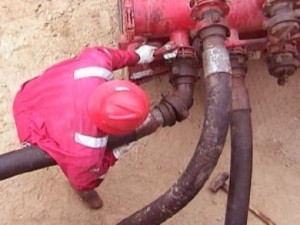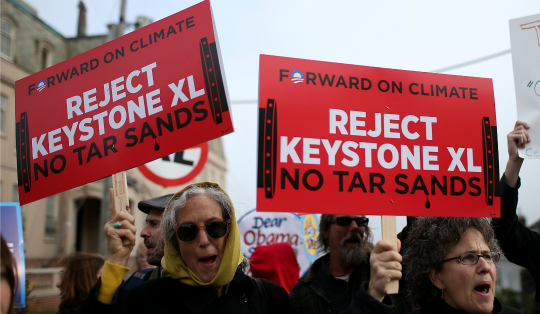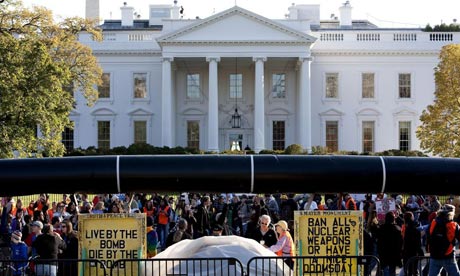FEBRUARY 12, 2014 | 6:30 AM
BY DAVE FEHLING

COURTESY OSHA
Acid solutions are trucked to drill sites and injected deep underground
Read about the history of oil drilling in Texas and you’ll find references to how wildcatters would pour barrels of hydrochloric acid into their wells. The acid would eat through underground rock formations and allow more oil to flow up the well.
That was decades ago. While a lot has changed in the drilling industry since then, using acid has not. It’s only gotten bigger. And in Texas, no one seems to have any idea of just how much hydrochloric, acetic, or hydrofluoric acid is being pumped into the ground.
“During my years with Shell, we did not have to go to the Railroad Commission [the state oil and gas regulator] to get approval for an acid job,” said Joe Dunn Clegg, a retired engineer who now teaches at the University of Houston. In his well drilling class, you’ll learn all about what the oil and gas industry calls acidizing.
Acidizing involves pumping hundreds of gallons of an acid solution down a well to dissolve rock formations blocking the flow of oil. After a number of hours, the solution is then brought back up to the surface and handled as a waste product.
In what’s called matrix acidizing, the solution is injected at a lower pressure so that it dissolves rather than fractures the rock formations, explained Clegg. But he said acidizing is also used in conjunction with high-pressure hydraulic fracturing, or “fracking.”
.
“I consider it a relatively safe operation. But it does involve handling acid, which you don’t want to spill on yourself,” said Clegg.
In fact, in 2011, a drilling industry group issued a “safety alert” warning of the dangers of pumping acid solutions at drilling sites.
No Statewide Data
Acidizing remains largely unregulated in Texas. According to the Railroad Commission of Texas, drilling operators are required to report the use of acid, but spokesperson Ramona Nye told StateImpact Texas in an email that the commission doesn’t track the data. Therefore, the commission said it couldn’t provide statewide data for how much or what types of acids are injected into wells annually, nor can the commission determine what counties have the highest amounts of acidizing.
Texas lawmakers passed a bill in 2011 that now requires drilling operators to report some chemicals used in the fracking process. But the bill doesn’t mention acidizing, and one of its authors said the technique wasn’t even on their radar.
“Acidizing is not nearly as widely discussed as fracking. It could in fact be as problematic as the fracking,” says Rep. Lon Burnam, a Democrat from Fort Worth. He’s a frequent critic of the drilling operations that have taken off dramatically in his district over the last decade.
New Acidizing Law in California
One place where acidizing has attracted more discussion is California. Though the state ranks fourth for oil production, far behind Texas (which leads the country), it’s got reason to be cautious: California has bigger earthquakes than Texas.
“What happens if there’s another earthquake and you’re injecting acid down into the shale? I just think those are questions no one has answered,” said Kate Gordon, Director of the Energy and Climate Program for Next Generation, a climate change and family advocacy group based in San Francisco.
“It’s hard to hear about acid going into the ground under the state’s major aquifers and not be a little freaked out by it,” Gordon told StateImpact Texas.
Next Generation commissioned a report on acidizing and supported a California law that took effect last month. It regulates fracking and acidizing, requiring drillers to alert adjacent landowners and monitor groundwater.
“Oil is very important to both Texas and California. I get that. It’s a big part of our state GDP. But we should have an honest and fact-based conversation about what it means to be getting at this stuff,” said Gordon.
Gordon couldn’t point to any drilling sites where groundwater has been contaminated by acidizing in California. And in Texas, a statewide inventory of groundwater contamination does not list any instances of acid contamination linked to drilling. Both the Texas Commission on Environmental Quality and the Railroad Commission of Texas said they know of no such cases.
Drilling Industry: It Only Sounds Bad
Halliburton and Baker Hughes are among the big drilling services companies that provide “well stimulation” that includes acidizing. An industry group, the Independent Petroleum Association of America, said that the term acidizing is a “harsh” sounding word that makes an easy target for critics. But Steve Everly, a spokesperson for Energy In Depth, an industry-funded research and publicity arm of the association, said environmental groups “don’t know what they’re talking about.”
“This is a technology that has been used in the oil fields since before we had a federal income tax. According to countless energy professionals across the country, who have been stimulating wells their entire careers, it’s a safe and well-understood process,” Everly wrote in an email to StateImpact Texas
Special thanks to Richard Charter

